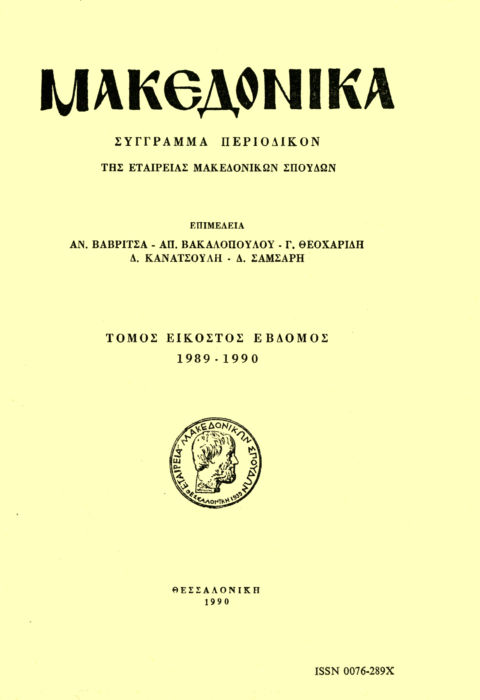Jesuit missions in Macedonia in the 17 and 18 c. Part Two
Abstract
After having mentioned the First part of his article on the Mission of the Jesuits in Macedonia, published in the 27th volume of «Makedonika», the author presents the Second Pait which begins in 1726 with the arrival of Father J. B. Souciet in Thessaloniki and ends with the interdiction of the Compagnie de Jésus (Societas Jesu) by Pope Clement XIV in 1773. Father J. B. Souciet is known to us from his description of the city of Thessaloniki as well as from his archaeological interests. We find proof of those in his correspondence with his brother Etienne, editor of the magazine «Mémoires de Trévoux».
Also Father Souciet wrote the chronicle of the foundation and early development of the Seat of the Jesuits in Thessaloniki pursuing the notes of the first Jesuit who settled in town, Father François Braconnier.
The successors of Father Souciet, J. B. Cresset, J. B. Charon, M. A. Charroi, A. Desprez, French, J. L. Alby, J. Délenda, N. Délenda, Greek and the Armenian Melchior Hermès, devoted themselves to the pastoral duties, the teaching of the young and the services for the prisoners and slaves for who they also founded «Le Bassin des Esclaves».
In 1740 is founded the church of Saint Louis at tne site where actually the Catholic church stands, 19 Frangon Street. Three years later the Catholic-community, which consisted of no more than 200 persons, mainly French, Italians and a few Greek families from Syros, Tinos and Smyrne, was organised in a parish.
The French consuls, in their correspondence with the Ministry of Foreign Affairs, the Marine and the Chamber of Commerce of Marseille, give us information on the activities of the Jesuits in Macedonia.
The last Jesuit priest in Thessaloniki was Father R. F. Guérin du Rocher. After six years of mission work in Northern Greece (1767-1773) he returned to Paris, where he died as a martyr in the period of the «Terreur». He wrote a study on the Greek Orthodox Church dedicated to the Archbishop of Paris.
Father Dapei from Chios remained in Thessaloniki, after the abolition of the Jesuits in 1773. His companion was Father Edouard Desperamo, a compatriot of his. They left Thessaloniki, the former for Constaninople, the last for Russia, after the Pères Lazaristes de Saint Vincent de Paul (1783) had taken charge of the Mission. The same Pères Lazaristes serve the Catholic community of Macedonia to this day.
At the end of the article, there are published some documents related to the Mission of the Jesuits in Macedonia: Their nomination as chaplains of the French consuls by Louis XIV (1706), a letter by Father F. Braconnier (1709), the document of the foundation of the parish. The originals are con served in the archives of the House of the Pères Lazaristes in Thessaloniki.
Article Details
- How to Cite
-
Ρούσσος-Μηλιδώνης Μ. Ν. (1992). Jesuit missions in Macedonia in the 17 and 18 c. Part Two. Makedonika, 28, 197–227. https://doi.org/10.12681/makedonika.152
- Issue
- Vol. 28
- Section
- Articles

This work is licensed under a Creative Commons Attribution-NonCommercial-ShareAlike 4.0 International License.
Authors who publish with this journal agree to the following terms:
- Authors retain copyright and grant the journal right of first publication with the work simultaneously licensed under a Creative Commons Attribution Non-Commercial License that allows others to share the work with an acknowledgement of the work's authorship and initial publication in this journal.
- Authors are able to enter into separate, additional contractual arrangements for the non-exclusive distribution of the journal's published version of the work (e.g. post it to an institutional repository or publish it in a book), with an acknowledgement of its initial publication in this journal.
- Authors are permitted and encouraged to post their work online (preferably in institutional repositories or on their website) prior to and during the submission process, as it can lead to productive exchanges, as well as earlier and greater citation of published work (See The Effect of Open Access).




